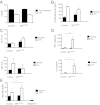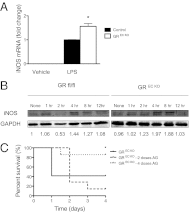Endothelial glucocorticoid receptor is required for protection against sepsis
- PMID: 23248291
- PMCID: PMC3538225
- DOI: 10.1073/pnas.1210200110
Endothelial glucocorticoid receptor is required for protection against sepsis
Abstract
The glucocorticoid receptor (GR) is ubiquitously expressed on nearly all cell types, but tissue-specific deletion of this receptor can produce dramatic whole organism phenotypes. In this study we investigated the role of the endothelial GR in sepsis in vivo and in vitro. Mice with an endothelial-specific GR deletion and controls were treated with 12.5 mg/kg LPS and phenotyped. Mice lacking GR showed significantly increased mortality, more hemodynamic instability, higher nitric oxide levels, and higher levels of the inflammatory cytokines, tumor necrosis factor-alpha (TNF-α) and interleukin-6 (IL-6) compared with controls. There were no differences in rates of apoptosis or macrophage recruitment between the two groups. Both endothelial nitric oxide synthase (eNOS) and inducible nitric oxide synthase (iNOS) expression were increased after LPS challenge in mice with endothelial GR deficiency, and aminoguanidine, a specific iNOS inhibitor in mice was able to rescue hemodynamic collapse in these animals. In vitro, human umbilical vein cells (HUVECs) subjected to GR knockdown by siRNA showed increased expression of eNOS at baseline that persisted after treatment with LPS. Both eNOS and iNOS mRNA was increased by qPCR. In HUVECs lacking GR, NF-κB levels and NF-κB-dependent genes tissue factor and IL-6 were increased compared with controls. Thus, endothelial GR is a critical regulator of NF-κB activation and nitric oxide synthesis in sepsis.
Conflict of interest statement
The authors declare no conflict of interest.
Figures





References
-
- Beato M, Sánchez-Pacheco A. Interaction of steroid hormone receptors with the transcription initiation complex. Endocr Rev. 1996;17(6):587–609. - PubMed
-
- Groeneweg FL, Karst H, de Kloet ER, Joëls M. Mineralocorticoid and glucocorticoid receptors at the neuronal membrane, regulators of nongenomic corticosteroid signalling. Mol Cell Endocrinol. 2012;350(2):299–309. - PubMed
-
- Stolte EH, van Kemenade BM, Savelkoul HF, Flik G. Evolution of glucocorticoid receptors with different glucocorticoid sensitivity. J Endocrinol. 2006;190(1):17–28. - PubMed
-
- Cole TJ, et al. Targeted disruption of the glucocorticoid receptor gene blocks adrenergic chromaffin cell development and severely retards lung maturation. Genes Dev. 1995;9(13):1608–1621. - PubMed
-
- Tronche F, Kellendonk C, Reichardt HM, Schütz G. Genetic dissection of glucocorticoid receptor function in mice. Curr Opin Genet Dev. 1998;8(5):532–538. - PubMed
Publication types
MeSH terms
Substances
Grants and funding
- HL61371/HL/NHLBI NIH HHS/United States
- HL64793/HL/NHLBI NIH HHS/United States
- P30 DK079310/DK/NIDDK NIH HHS/United States
- U24 DK59635/DK/NIDDK NIH HHS/United States
- K08-DK078623/DK/NIDDK NIH HHS/United States
- R37 HL061371/HL/NHLBI NIH HHS/United States
- R01 HL096670/HL/NHLBI NIH HHS/United States
- K08 DK078623/DK/NIDDK NIH HHS/United States
- R01 HL081190/HL/NHLBI NIH HHS/United States
- R01 HL061371/HL/NHLBI NIH HHS/United States
- HL096670/HL/NHLBI NIH HHS/United States
- P01 HL107205/HL/NHLBI NIH HHS/United States
- HHMI/Howard Hughes Medical Institute/United States
- R01 HL064793/HL/NHLBI NIH HHS/United States
- HL081190/HL/NHLBI NIH HHS/United States
- U24 DK059635/DK/NIDDK NIH HHS/United States
LinkOut - more resources
Full Text Sources
Medical
Molecular Biology Databases

